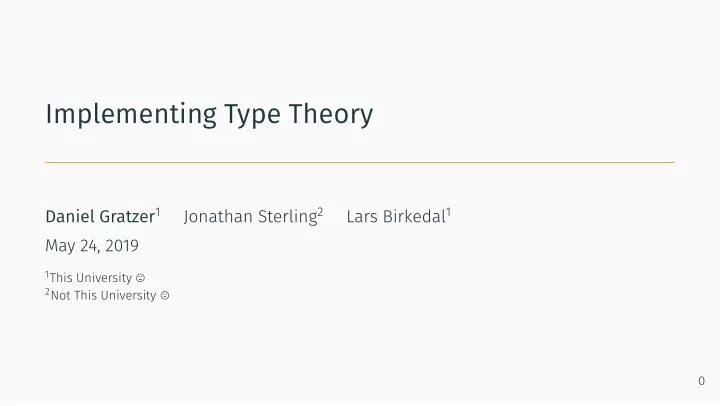

Implementing Type Theory Daniel Gratzer 1 Jonathan Sterling 2 Lars Birkedal 1 May 24, 2019 0 1 This University � 2 Not This University �
Some Terminology Languages classify expressions into different types ( int , string , char ). Type System The rules for what expressions belong to which types. Type-Checker The program that makes sure we follow the rules. 1
Setting the Scene What is type theory? Type theory is a.... Mathematics Programming Type Theory 2 • programming language with a rich type system. • framework for reasoning about mathematical objects.
Setting the Scene What is type theory? Type theory is a.... Mathematics Programming Type Theory 2 • programming language with a rich type system. • framework for reasoning about mathematical objects.
A Concrete Issue Set aside the questions of mathematics and programming for a second. Type theory has functions Example When is this application well-typed? 3 useful _ function ( important _ argument )
A Concrete Issue Set aside the questions of mathematics and programming for a second. Type theory has functions Example When is this application well-typed? must have type 3 useful _ function ( important _ argument ) A → B
A Concrete Issue Set aside the questions of mathematics and programming for a second. Type theory has functions Example When is this application well-typed? must have type must have type C 3 useful _ function ( important _ argument ) A → B
A Concrete Issue Set aside the questions of mathematics and programming for a second. Type theory has functions Example When is this application well-typed? must have type must have type C 3 useful _ function ( important _ argument ) We must also have A = C A → B
How Hard is Type-Checking? What should we take away from this example? 1. In order to type-check, we must check if two types are equal. 2. So we need a program checking type equality. 4
Just Type Equality? Deciding type equality is always a problem but we have fancier types: A list of A s of length n We need more than type equality... we need term equality too! Vec A 2 n Vec A n n 5 Vec ( A , n )
Just Type Equality? Deciding type equality is always a problem but we have fancier types: A list of A s of length n We need more than type equality... we need term equality too! 5 Vec ( A , n ) Vec ( A , 2 ∗ n ) ? = Vec ( A , n + n )
The Mess We’re In In order to implement type theory we must check the equality of terms. 1. This is completely impossible in a Turing-complete language 1 . 2. Actually it’s impossible in many Turing- incomplete languages as well. 3. Many equalities we expect are impossible to automatically check: 1 Python, Java, C, C++, PostScript, and Magic the Gathering are all Turing-complete 6 f = g ⇐⇒ for all x , f ( x ) = g ( x )
Modern Type Theory The central balancing act is then defjning an equality relation which is 7 • strong enough to match our mathematical intuitions. • simple enough that we can implement it.
Our Work We designed a theory of equality for a particular modal type theory. In both cases, having an implementation was important! 8 • The type theory was mathematically motivated. • But it is still interesting for programmming.
Implementing Modal Type Theory The Process 2 : 1. Write down the rules of the type system. (2 pages) (90 pages) (300 lines) See our paper: https://jozefg.github.io/modal.pdf 2 Elided: the coffee & false starts, or where I get distracted by random Wikipedia articles. 9 2. Prove the decidability of type-checking. 3. Implement the type-checker.
Conclusions (Some of the Stuff I Skipped) I cut out a lot of cool stuff in this talk: Many unexplored and interesting questions remain... 10 • Using type theory, we can “run” math proofs. • We can use computer science to explore mathematics. • We can use maths to inspire better PLs.
The LogSem Group If this sounds interesting, please come talk to us! 11
Recommend
More recommend